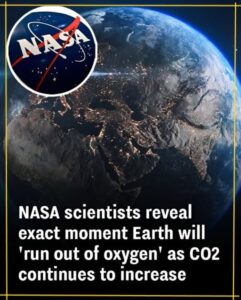NASA-Backed Study Predicts When Earth Will Lose Its Breathable Air

Take a deep breath—while you still can. A groundbreaking study supported by NASA suggests that Earth’s life-sustaining oxygen won’t last indefinitely. Although the shift won’t affect us or countless future generations, the research paints a sobering picture of what lies ahead in our planet’s distant future.
According to scientists, Earth’s atmosphere is destined to undergo a dramatic transformation within the next billion years. As a result, the oxygen-rich environment that has nurtured complex life could vanish, plunging the planet back into a state inhospitable to animals and plants.
This isn’t the plot of a sci-fi film. It’s a scientific forecast grounded in cutting-edge climate modeling—and it carries huge implications for our understanding of life on Earth and beyond.
Earth’s Breathable Atmosphere Has an Expiration Date
Using complex simulations of Earth’s climate and atmospheric dynamics, researchers Kazumi Ozaki (Toho University) and Christopher Reinhard (Georgia Tech) uncovered that Earth’s oxygen levels could drop to less than 10% of what they are today—potentially within a billion years.
That level of oxygen would be far too low to support animals, plants, or most forms of microbial life. Essentially, Earth would revert to a version of itself that predates the rise of oxygen-dependent organisms.
And once the decline begins, it could move faster than expected. On a geological timescale, the drop in oxygen might be abrupt, leaving little room for adaptation.
What Causes the Oxygen Collapse?
At the heart of the transformation is our very own Sun. Over time, the Sun’s brightness will increase, triggering changes in Earth’s climate. As sunlight intensifies, it accelerates chemical reactions in the atmosphere, warming the planet and disrupting the carbon cycle.
Specifically, the carbonate-silicate cycle—which helps regulate CO₂—will slow down. As CO₂ levels dwindle, plants will lose their ability to photosynthesize. And with photosynthesis gone, oxygen production grinds to a halt.
Eventually, Earth’s atmosphere could become rich in methane and low in oxygen—eerily resembling the planet’s conditions before life as we know it emerged.
Even before oxygen fully disappears, surface conditions will grow extreme. Rising temperatures, loss of protective ozone, and erratic atmospheric changes will push ecosystems toward collapse long before the final breath is gone.
Looking for Life in the Universe Just Got Harder
When astronomers hunt for signs of life on distant planets, they often focus on oxygen as a key indicator. After all, on Earth, oxygen is tied closely to living organisms.
But this research introduces a critical twist: oxygen may not always be present—even on planets that once supported complex life.
That means a planet could be teeming with life one billion years, and appear lifeless the next, simply because of atmospheric evolution. If we only look for oxygen, we might miss other biosignatures and overlook alien worlds that are very much alive.
The findings urge scientists to widen their search and consider a broader range of gases when analyzing exoplanet atmospheres.
What This Means for Us Today
Although this study speaks to events far beyond any human timescale, it still carries relevance for our current environmental outlook.
Some researchers are already experimenting with geoengineering—techniques that aim to counteract climate change by reflecting sunlight or altering atmospheric chemistry. These interventions, while controversial, underscore how delicate and dynamic Earth’s climate systems truly are.
For now, NASA assures us that Earth’s oxygen levels are stable. But the research is a reminder: the conditions that sustain life are not guaranteed forever. And while this future may be a billion years away, the insight it gives us about planetary habitability—and its limits—should influence how we care for our world now.
Final Thought: A Billion-Year Warning with a Present-Day Message
Earth’s ability to support life is not permanent. As the Sun ages and CO₂ declines, our planet will gradually lose the oxygen that makes complex organisms possible. The changes will be irreversible—and fast, in planetary terms.
This isn’t just about our future. It’s about learning how to read the stories written in planetary atmospheres—our own and those light-years away. By understanding how Earth may lose its breath, we gain new clarity on what it means to live here now.